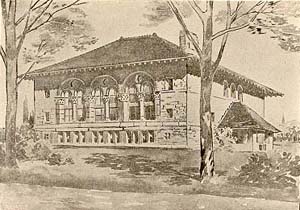Early Years of the College (1874 - 1900)
In the early years, the college included a preparatory school (called the Cutler Academy which lasted until 1914). With few students ready for college work, the mathematics consisted mainly of algebra (from a text by Loomis), trigonometry (from the same text), and geometry (from Frank Loud's text). Students had to exhibit understanding of algebra up through "simultaneous quadratics" before being admitted to the college. College level mathematics included further study in algebra, trigonometry, and geometry plus assorted courses such as "mental arithmetic" and spherical trigonometry (from a text by Olney).
In the 1889 bulletin of the college, mathematics for the first time appears as a coherent course of study with an attendant teaching philosophy.
The course in this science will be adjusted as far as practicable to the needs of the two classes of students which in this department, more perhaps than any other, become clearly distinct as the work is taken up. To those whose mental habit, natural or acquired, is such as to render mathematical study irksome, such study does not therefore become valueless, rather, indeed, it is peculiarly necessary; yet the method pursued should be modified from that adapted to students who show greater aptitude, and who will be encouraged to acquire familiarity with the more advanced methods of calculation, such as are essential in the investigations of physical science.
College freshmen studied plane and spherical trigonometry and advanced algebra including logarithms, binomial theorem (with general exponent), other infinite series, and solutions of numerical equations of any degree. Sophomores moved on to the analytic geometry of conic sections and the beginnings of calculus. No pure mathematics was required beyond the second year, but there were electives offered which continued calculus and geometry (analytical and projective). Under Frank Loud's influence, astronomy was early on connected with the study of mathematics, and later was required of students seeking a degree in mathematics. For a time, mathematics and astronomy courses were listed together.

Coburn Library completed in 1893. Drawing from 1893 college catalogue.
In the 1896 listing of mathematics courses, it is worth noting that the History of Mathematics is offered. This was an elective aimed towards students pursuing a teaching career and has its own unique history at the college. Also listed in 1896 is the Theory of Substitutions which used the book by Netto to introduce the concepts of an algebraic group. Cajori and Loud were apparently eager to stay current in mathematics education; the Netto book was translated into English in 1892.
A course in differential equations was added to the curriculum in 1897 followed by courses in synthetic geometry, theory of equations, and surveying!
At this time, the college offered three degrees: Bachelor of Arts, Bachelor of Philosophy, and Bachelor of Science. The idea of a "major" subject of study was not well-developed, but for students interested in mathematics, there were few requirements; aside from the standard algebra, trigonometry, and geometry, some astronomy was required and the Bachelor of Science degree required calculus.


